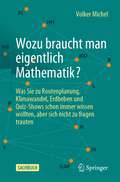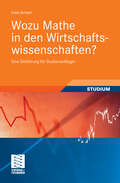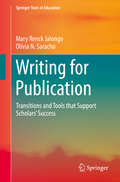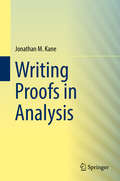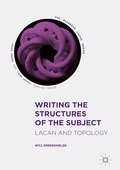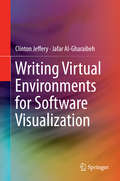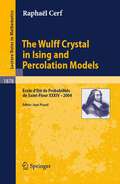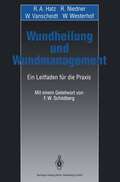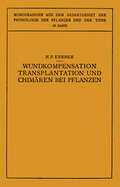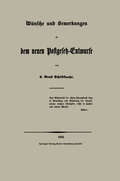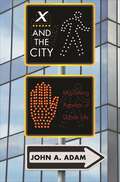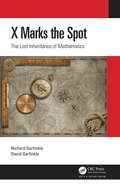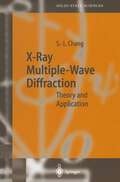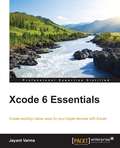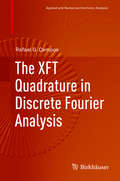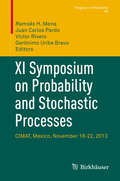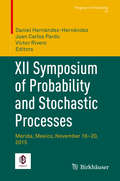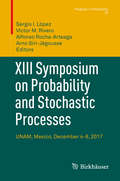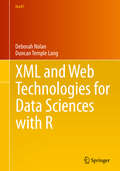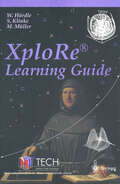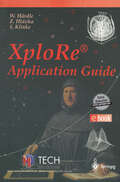- Table View
- List View
Wozu braucht man eigentlich Mathematik?: Was Sie zu Routenplanung, Klimawandel, Erdbeben und Quiz-Shows schon immer wissen wollten, aber sich nicht zu fragen trauten
by Volker MichelWozu braucht man eigentlich Mathematik? Haben Sie sich das auch schon gefragt oder sind Sie selbst Mathematiker/-in und hören dies oft?Mathematik ist weit mehr als die Suche nach der nächsten Primzahl oder dem x-ten Beweis des Satzes von Pythagoras. Mathematik ist eine zentrale Schlüsseltechnologie für viele Wissenschaftsbereiche. Die Frage, ob es einen Klimawandel gibt und wie man Veränderungen im Klima beobachtet, kann ohne Mathematik genauso wenig beantwortet werden wie die Frage, wie sich eine Pandemie ausbreitet. Viele weitere Beispiele werden in dem Buch angesprochen.In einem lockeren Erzählstil erläutert der Autor, wo überall Mathematik verborgen ist und wie man mit einfachen Mitteln schon verstehen kann, wie brisante Probleme gelöst werden. Vorausgesetzt werden (je nach Kapitel) teils gar keine Mathematik-Vorkenntnisse bis maximal zum Abitur-Wissen.
Wozu Mathe in den Wirtschaftswissenschaften?: Eine Einführung für Studienanfänger (Studienbücher Wirtschaftsmathematik)
by Uwe JensenDieses Buch zeigt an einfachen Beispielen, wozu mathematisches Verständnis (neben reinen Rechenfertigkeiten) in den Fächern der Betriebs- und Volkswirtschaftslehre gebraucht wird, um ökonomische Prozesse analysieren zu können. Es beschreibt zunächst die zentrale Bedeutung von Funktionen, führt in lockerer Sprache in wissenschaftliches Modelldenken ein und erläutert die wichtige Abwägung zwischen Einfachheit und Genauigkeit der Modelle. Danach wird verdeutlicht, wie aus der Schule bekannte mathematische Konzepte (wie Exponential- und Logarithmusfunktionen, Ableitungen, Gleichungssysteme, Abstandsmaße und Wahrscheinlichkeiten) zu kraftvollen Verfahren zur Lösung wirtschaftswissenschaftlicher Probleme werden. Das Buch möchte Studienanfängern und interessierten Schülerinnen und Schülern elementare Grundfertigkeiten und Motivation geben, sich mit Mathe im Anwendungsbereich der Ökonomie zu beschäftigen.
Write the missing numbers (tactile)
by Adrian FarnsworthThese four pages show a number line which has some points with missing numbers and labelled by a letter.
Writing for Publication: Transitions and Tools that Support Scholars’ Success (Springer Texts in Education)
by Mary Renck Jalongo Olivia N. SarachoThis book offers systematic instruction and evidence-based guidance to academic authors. It demystifies scholarly writing and helps build both confidence and skill in aspiring and experienced authors. The first part of the book focuses on the author’s role, writing’s risks and rewards, practical strategies for improving writing, and ethical issues. Part Two focuses on the most common writing tasks: conference proposals, practical articles, research articles, and books. Each chapter is replete with specific examples, templates to generate a first draft, and checklists or rubrics for self-evaluation. The final section of the book counsels graduate students and professors on selecting the most promising projects; generating multiple related, yet distinctive, publications from the same body of work; and using writing as a tool for professional development. Written by a team that represents outstanding teaching, award-winning writing, and extensive editorial experience, the book leads teacher/scholar/authors to replace the old “publish or perish” dictum with a different, growth-seeking orientation: publish and flourish.
Writing Proofs in Analysis
by Jonathan M. KaneThis is a textbook on proof writing in the area of analysis, balancing a survey of the core concepts of mathematical proof with a tight, rigorous examination of the specific tools needed for an understanding of analysis. Instead of the standard "transition" approach to teaching proofs, wherein students are taught fundamentals of logic, given some common proof strategies such as mathematical induction, and presented with a series of well-written proofs to mimic, this textbook teaches what a student needs to be thinking about when trying to construct a proof. Covering the fundamentals of analysis sufficient for a typical beginning Real Analysis course, it never loses sight of the fact that its primary focus is about proof writing skills.This book aims to give the student precise training in the writing of proofs by explaining exactly what elements make up a correct proof, how one goes about constructing an acceptable proof, and, by learning to recognize a correct proof, how to avoid writing incorrect proofs. To this end, all proofs presented in this text are preceded by detailed explanations describing the thought process one goes through when constructing the proof. Over 150 example proofs, templates, and axioms are presented alongside full-color diagrams to elucidate the topics at hand.
Writing the Structures of the Subject: Lacan and Topology
by Will GreenshieldsThis book examines and explores Jacques Lacan’s controversial topologisation of psychoanalysis, and seeks to persuade the reader that this enterprise was necessary and important. In providing both an introduction to a fundamental component of Lacan’s theories, as well as readings of texts that have been largely ignored, it provides a thorough critical interpretation of his work. Will Greenshields argues that Lacan achieved his most pedagogically clear and successful presentations of his most essential and notoriously complex concepts – such as structure, the subject and the real – through the deployment of topology. The book will help readers to better understand Lacan, and also those concepts that have become prevalent in various intellectual discourses such as contemporary continental philosophy, politics and the study of ideology, and literary or cultural criticism.
Writing the Structures of the Subject: Lacan and Topology (PDF)
by Will GreenshieldsThis book examines and explores Jacques Lacan’s controversial topologisation of psychoanalysis, and seeks to persuade the reader that this enterprise was necessary and important. In providing both an introduction to a fundamental component of Lacan’s theories, as well as readings of texts that have been largely ignored, it provides a thorough critical interpretation of his work. Will Greenshields argues that Lacan achieved his most pedagogically clear and successful presentations of his most essential and notoriously complex concepts – such as structure, the subject and the real – through the deployment of topology. The book will help readers to better understand Lacan, and also those concepts that have become prevalent in various intellectual discourses such as contemporary continental philosophy, politics and the study of ideology, and literary or cultural criticism.
Writing Virtual Environments for Software Visualization
by Clinton Jeffery Jafar Al-GharaibehWriting Virtual Environments for Software Visualization book describes the software for a networked, 3D multi-user virtual environment that allows users to create and share remotely visualizations of program behavior. Collaborative virtual environments such as World of Warcraft or Second Life are a popular way to share interactive internet experiences, but they are complex and difficult to create. Software visualization is an area that may enable important advances in our ability to understand and reduce the costs of maintaining software. Applying the former technology to this problem area will be valuable to distributed and multi-institutional software development and educational users. The author covers the major features of collaborative virtual environments and how to program them in a very high level language. The book also examines the application of popular game-like software technologies.
The Wulff Crystal in Ising and Percolation Models: Ecole d'Eté de Probabilités de Saint-Flour XXXIV - 2004 (Lecture Notes in Mathematics #1878)
by Raphaël CerfThis volume is a synopsis of recent works aiming at a mathematically rigorous justification of the phase coexistence phenomenon, starting from a microscopic model. It is intended to be self-contained. Those proofs that can be found only in research papers have been included, whereas results for which the proofs can be found in classical textbooks are only quoted.
Wundheilung und Wundmanagement: Ein Leitfaden für die Praxis
by R.A. Hatz R. Niedner W. Vanscheidt W. WesterhofWundkompensation Transplantation und Chimären bei Pflanzen (Monographien aus dem Gesamtgebiet der Physiologie der Pflanzen und der Tiere)
by N.P. Krenke N. Busch O. MoritzDieser Buchtitel ist Teil des Digitalisierungsprojekts Springer Book Archives mit Publikationen, die seit den Anfängen des Verlags von 1842 erschienen sind. Der Verlag stellt mit diesem Archiv Quellen für die historische wie auch die disziplingeschichtliche Forschung zur Verfügung, die jeweils im historischen Kontext betrachtet werden müssen. Dieser Titel erschien in der Zeit vor 1945 und wird daher in seiner zeittypischen politisch-ideologischen Ausrichtung vom Verlag nicht beworben.
X and the City: Modeling Aspects of Urban Life
by John A. AdamX and the City, a book of diverse and accessible math-based topics, uses basic modeling to explore a wide range of entertaining questions about urban life. How do you estimate the number of dental or doctor's offices, gas stations, restaurants, or movie theaters in a city of a given size? How can mathematics be used to maximize traffic flow through tunnels? Can you predict whether a traffic light will stay green long enough for you to cross the intersection? And what is the likelihood that your city will be hit by an asteroid? Every math problem and equation in this book tells a story and examples are explained throughout in an informal and witty style. The level of mathematics ranges from precalculus through calculus to some differential equations, and any reader with knowledge of elementary calculus will be able to follow the materials with ease. There are also some more challenging problems sprinkled in for the more advanced reader. Filled with interesting and unusual observations about how cities work, X and the City shows how mathematics undergirds and plays an important part in the metropolitan landscape.
X and the City: Modeling Aspects of Urban Life
by John A. AdamX and the City, a book of diverse and accessible math-based topics, uses basic modeling to explore a wide range of entertaining questions about urban life. How do you estimate the number of dental or doctor's offices, gas stations, restaurants, or movie theaters in a city of a given size? How can mathematics be used to maximize traffic flow through tunnels? Can you predict whether a traffic light will stay green long enough for you to cross the intersection? And what is the likelihood that your city will be hit by an asteroid? Every math problem and equation in this book tells a story and examples are explained throughout in an informal and witty style. The level of mathematics ranges from precalculus through calculus to some differential equations, and any reader with knowledge of elementary calculus will be able to follow the materials with ease. There are also some more challenging problems sprinkled in for the more advanced reader. Filled with interesting and unusual observations about how cities work, X and the City shows how mathematics undergirds and plays an important part in the metropolitan landscape.
X Marks the Spot: The Lost Inheritance of Mathematics
by Richard Garfinkle David GarfinkleX Marks the Spot is written from the point of view of the users of mathematics. Since the beginning, mathematical concepts and techniques (such as arithmetic and geometry) were created as tools with a particular purpose like counting sheep and measuring land areas. Understanding those purposes leads to a greater understanding of why mathematics developed as it did. Later mathematical concepts came from a process of abstracting and generalizing earlier mathematics. This process of abstraction is very powerful, but often comes at the price of intuition and understanding. This book strives to give a guided tour of the development of various branches of mathematics (and what they’re used for) that will give the reader this intuitive understanding. Features Treats mathematical techniques as tools, and areas of mathematics as the result of abstracting and generalizing earlier mathematical tools Written in a relaxed conversational and occasionally humorous style making it easy to follow even when discussing esoterica. Unravels how mathematicians think, demystifying math and connecting it to the ways non-mathematicians think and connecting math to people’s lives Discusses how math education can be improved in order to prevent future generations from being turned off by math.
X Marks the Spot: The Lost Inheritance of Mathematics
by Richard Garfinkle David GarfinkleX Marks the Spot is written from the point of view of the users of mathematics. Since the beginning, mathematical concepts and techniques (such as arithmetic and geometry) were created as tools with a particular purpose like counting sheep and measuring land areas. Understanding those purposes leads to a greater understanding of why mathematics developed as it did. Later mathematical concepts came from a process of abstracting and generalizing earlier mathematics. This process of abstraction is very powerful, but often comes at the price of intuition and understanding. This book strives to give a guided tour of the development of various branches of mathematics (and what they’re used for) that will give the reader this intuitive understanding. Features Treats mathematical techniques as tools, and areas of mathematics as the result of abstracting and generalizing earlier mathematical tools Written in a relaxed conversational and occasionally humorous style making it easy to follow even when discussing esoterica. Unravels how mathematicians think, demystifying math and connecting it to the ways non-mathematicians think and connecting math to people’s lives Discusses how math education can be improved in order to prevent future generations from being turned off by math.
X-Ray Multiple-Wave Diffraction: Theory and Application (Springer Series in Solid-State Sciences #143)
by Shih-Lin ChangX-ray multiple-wave diffraction, sometimes called multiple diffraction or N-beam diffraction, results from the scattering of X-rays from periodic two or higher-dimensional structures, like 2-d and 3-d crystals and even quasi crystals. The interaction of the X-rays with the periodic arrangement of atoms usually provides structural information about the scatterer. Unlike the usual Bragg reflection, the so-called two-wave diffraction, the multiply diffracted intensities are sensitive to the phases of the structure factors in volved. This gives X-ray multiple-wave diffraction the chance to solve the X-ray phase problem. On the other hand, the condition for generating an X ray multiple-wave diffraction is much more strict than in two-wave cases. This makes X-ray multiple-wave diffraction a useful technique for precise measure ments of crystal lattice constants and the wavelength of radiation sources. Recent progress in the application of this particular diffraction technique to surfaces, thin films, and less ordered systems has demonstrated the diver sity and practicability of the technique for structural research in condensed matter physics, materials sciences, crystallography, and X-ray optics. The first book on this subject, Multiple Diffraction of X-Rays in Crystals, was published in 1984, and intended to give a contemporary review on the fundamental and application aspects of this diffraction.
Xcode 6 Essentials
by Jayant VarmaThis book is aimed at developers who want to make applications for Apple devices with Xcode. iOS developers who have experience using other frameworks and languages can now migrate to Xcode and build creative, native apps.
The XFT Quadrature in Discrete Fourier Analysis (Applied and Numerical Harmonic Analysis)
by Rafael G. CamposThis book has two main objectives, the first of which is to extend the power of numerical Fourier analysis and to show by means of theoretical examples and numerous concrete applications that when computing discrete Fourier transforms of periodic and non periodic functions, the usual kernel matrix of the Fourier transform, the discrete Fourier transform (DFT), should be replaced by another kernel matrix, the eXtended Fourier transform (XFT), since the XFT matrix appears as a convergent quadrature of a more general transform, the fractional Fourier transform. In turn, the book’s second goal is to present the XFT matrix as a finite-dimensional transformation that links certain discrete operators in the same way that the corresponding continuous operators are related by the Fourier transform, and to show that the XFT matrix accordingly generates sequences of matrix operators that represent continuum operators, and which allow these operators to be studied from another perspective.
XI Symposium on Probability and Stochastic Processes: CIMAT, Mexico, November 18-22, 2013 (Progress in Probability #69)
by Ramsés H. Mena Juan Carlos Pardo Víctor Rivero Gerónimo Uribe BravoThis volume features a collection of contributed articles and lecture notes from the XI Symposium on Probability and Stochastic Processes, held at CIMAT Mexico in September 2013. Since the symposium was part of the activities organized in Mexico to celebrate the International Year of Statistics, the program included topics from the interface between statistics and stochastic processes.
XII Symposium of Probability and Stochastic Processes: Merida, Mexico, November 16–20, 2015 (Progress in Probability #73)
by Daniel Hernández-Hernández Juan Carlos Pardo Victor RiveroThis volume contains the proceedings of the XII Symposium of Probability and Stochastic Processes which took place at Universidad Autonoma de Yucatan in Merida, Mexico, on November 16–20, 2015. This meeting was the twelfth meeting in a series of ongoing biannual meetings aimed at showcasing the research of Mexican probabilists as well as promote new collaborations between the participants.The book features articles drawn from different research areas in probability and stochastic processes, such as: risk theory, limit theorems, stochastic partial differential equations, random trees, stochastic differential games, stochastic control, and coalescence. Two of the main manuscripts survey recent developments on stochastic control and scaling limits of Markov-branching trees, written by Kazutoshi Yamasaki and Bénédicte Haas, respectively. The research-oriented manuscripts provide new advances in active research fields in Mexico.The wide selection of topics makes the book accessible to advanced graduate students and researchers in probability and stochastic processes.
XIII Symposium on Probability and Stochastic Processes: UNAM, Mexico, December 4-8, 2017 (Progress in Probability #75)
by Sergio I. López Víctor M. Rivero Alfonso Rocha-Arteaga Arno Siri-JégousseThis volume features a collection of contributed articles and lecture notes from the XIII Symposium on Probability and Stochastic Processes, held at UNAM, Mexico, in December 2017.It is split into two main parts: the first one presents lecture notes of the course provided by Mauricio Duarte, followed by its second part which contains research contributions of some of the participants.
XML and Web Technologies for Data Sciences with R (Use R!)
by Deborah Nolan Duncan Temple LangWeb technologies are increasingly relevant to scientists working with data, for both accessing data and creating rich dynamic and interactive displays. The XML and JSON data formats are widely used in Web services, regular Web pages and JavaScript code, and visualization formats such as SVG and KML for Google Earth and Google Maps. In addition, scientists use HTTP and other network protocols to scrape data from Web pages, access REST and SOAP Web Services, and interact with NoSQL databases and text search applications. This book provides a practical hands-on introduction to these technologies, including high-level functions the authors have developed for data scientists. It describes strategies and approaches for extracting data from HTML, XML, and JSON formats and how to programmatically access data from the Web. Along with these general skills, the authors illustrate several applications that are relevant to data scientists, such as reading and writing spreadsheet documents both locally and via Google Docs, creating interactive and dynamic visualizations, displaying spatial-temporal displays with Google Earth, and generating code from descriptions of data structures to read and write data. These topics demonstrate the rich possibilities and opportunities to do new things with these modern technologies. The book contains many examples and case-studies that readers can use directly and adapt to their own work. The authors have focused on the integration of these technologies with the R statistical computing environment. However, the ideas and skills presented here are more general, and statisticians who use other computing environments will also find them relevant to their work.Deborah Nolan is Professor of Statistics at University of California, Berkeley.Duncan Temple Lang is Associate Professor of Statistics at University of California, Davis and has been a member of both the S and R development teams.
XploRe — Learning Guide: Learning Guide
by W. Härdle S. Klinke M. MüllerIt is generally accepted that training in statistics must include some exposure to the mechanics of computational statistics. This learning guide is intended for beginners in computer-aided statistical data analysis. The prerequisites for XploRe - the statistical computing environment - are an introductory course in statistics or mathematics. The reader of this book should be familiar with basic elements of matrix algebra and the use of HTML browsers. This guide is designed to help students to XploRe their data, to learn (via data interaction) about statistical methods and to disseminate their findings via the HTML outlet. The XploRe APSS (Auto Pilot Support System) is a powerful tool for finding the appropriate statistical technique (quantlet) for the data under analysis. Homogeneous quantlets are combined in XploRe into quantlibs. The XploRe language is intuitive and users with prior experience of other sta tistical programs will find it easy to reproduce the examples explained in this guide. The quantlets in this guide are available on the CD-ROM as well as on the Internet. The statistical operations that the student is guided into range from basic one-dimensional data analysis to more complicated tasks such as time series analysis, multivariate graphics construction, microeconometrics, panel data analysis, etc. The guide starts with a simple data analysis of pullover sales data, then in troduces graphics. The graphics are interactive and cover a wide range of dis plays of statistical data.
XploRe® - Application Guide
by W. Härdle Z. Hlavka S. KlinkeThis book offers a detailed application guide to XploRe - an interactive statistical computing environment. As a guide it contains case studies of real data analysis situations. It helps the beginner in statistical data analysis to learn how XploRe works in real life applications. Many examples from practice are discussed and analysed in full length. Great emphasis is put on a graphic based understanding of the data interrelations. The case studies include: Survival modelling with Cox's proportional hazard regression, Vitamin C data analysis with Quantile Regression, and many others.
